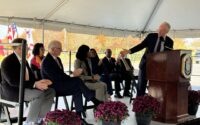Governor Laura Kelly recently touted her administration’s economic track record in a press release from the Office of the Governor. Specifically, Kelly cited over $16 billion in private-sector investments and the creation of over 60,000 jobs in Kansas since she took office as governor.
To grow the economy, Kelly has offered tax incentive packages to lure businesses to Kansas and encourage Kansas-based corporations to expand their economic footprint in the state. These incentive packages have been a key part in reaching investment deals with Panasonic, Integra Technologies, and EMP Shield.
Tax incentive packages have become a valuable tool for state and local policymakers trying to attract investment in a fiercely competitive economic environment. For example, when Amazon announced it was seeking proposals for a second headquarters in 2017, a bidding war ensued with cities offering land, tax breaks, and promised investments in public transit, among other enticements to convince Amazon to consider their jurisdictions.
The Amazon headquarters decision may be an extreme example, but it illustrates the new normal of policymakers offering lucrative incentives to attract economic investment.
Proponents argue that tax incentive packages have several benefits. First, increased financial investment and job creation can serve as a catalyst for state and local economies. By convincing businesses to establish or expand economic operations within their state or locality, policymakers create job opportunities.
Tax incentives may also lead to increases in tax revenue. This may seem paradoxical, but the argument is that by generating economic activity, governments will recoup whatever tax breaks they initially offered in future revenues from corporate, income, sales, and property taxes.
Finally, by offering tax incentives, policymakers create a competitive advantage over neighboring states, positioning themselves as an attractive destination for investment. This bolsters a state’s reputation as a hub for economic activity, which may in turn attract more investment.
Tax incentive plans, however, are not without detractors. One concern associated with these plans is the loss of revenue for states and localities. When policymakers offer tax breaks to businesses, it reduces the tax base, constraining funds available for key public services such as education or healthcare. This negative consequence can be particularly challenging for cities as they attempt to balance their tight budgets.
Further, these incentive plans create an uneven playing field. They often provide economic benefits to large corporations and businesses. Small businesses and individual taxpayers, on the other hand, do not have access to these same benefits. This worry is not without merit as some of the details of these deals are not made public during negotiation.
Finally, critics argue that tax incentive plans are short-term solutions. Businesses may decide to locate or invest in a state based on the availability of tax incentives, but they do not guarantee long-term investment. Neighboring states can offer similar deals in the future, leading to a cycle of relocation that creates economic instability for everyone. This dynamic, described by Dr. Michael Smith in his column “Tax truce is holding, but it’s time to finish the job,” can be seen in past tax border wars in the Kansas City metropolitan area.
The reality is that policymakers, like Governor Kelly, understand that tax incentives are the price of doing business in our global, competitive economy. The question that remains is do the benefits always outweigh the drawbacks?
Brianne Heidbreder, PhD is an Associate Professor of Political Science at Kansas State University.

